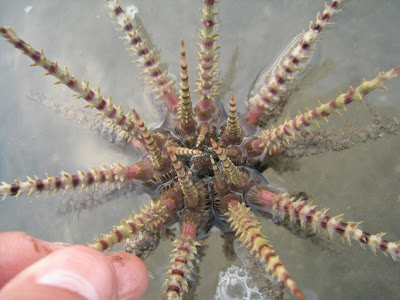:: The air was still, nary a breeze on this muggy Saturday morning. Not single star in the sky. ::
:: ...but lots of stars on the sand/silt/substrate. I didn’t realized that early in the morning but when dawn came, the shore was crawling with stars. Here we have two specimens of biscuit sea star (Goniodiscaster scaber). ::


:: Cake sea stars( Anthenea aspera) are the other kind of star easily found here on BB. I have yet to really comprehend how to id juvenile biscuit and cake sea stars. More here on wild films blog on the intricacies of sea star id. ::
:: What shore trip would be complete without a sighting of knobblies (Protoreaster nodosus). We found these 5 knobblies in this intriguing arrangement. ::
:: And I found a beautiful powdery gray coloured sea star. Apparently, it probably is a Craspidaster hesperus and we have never seen it intertidally before in Singapore. And as Ria pointed out, you can see tiny stars shaped spinelets on its upper surface. How cool is that! ::


:: As said, some creatures rare on mainland can be found in great numbers on BB. I have never seen pencil sea urchins (Prionocidaris bispinosa) before but when morning came, so many could be found amongst the coral rubble that we had to be really careful in case we stepped on them ::


:: Here we have a pair of Onyx cowries (Cypraea onyx). This cowrie is listed among the threatened animals of Singapore due to habitat loss and over-collection and is rarely seen. The paler cowrie is called the Wandering cowrie (Cypraea errones). Cowries have shiny shells cause their mantle usually covers its entire shell, thus algae and stuff wont get the chance to grow on it. In the past, cowries were used as currency due to their polished and shiny appearances. ::
:: Another unusual and elusive snail spotted was this ovulid snail. Found amongst the attractive soft coral which resembles cauliflower, these ovulid snalls have a mantle which covers their shell where it imitates the bumps and colouring of the coral polyps of their host. Its really hard to spot, where rumour has it that a local diver flew all the way to Phillipines to take a photo of this snail, only to be told that it can found here in Singapore waters. ::
:: These clumps or balls of these flowery soft corals, in pinks and cream, are rather common on BB. If you take a closer look, many tiny polps can be seen at the tips of the branches, through which this animal catches minute prey. ::
:: And I was very lucky to spot this white shrimp living amongst the branches. Apparently, usually a pair lives amongst the clumps of the soft coral, giving it a safe secure home. ::
:: Many anemones were spotted as well. According to Kok Sheng, this is a swimming anemone. ::
:: Another first for me is this rare bailer snail (Melo melo). Threatened in Singapore cause irresponsible people poach them for food, this carnivorous snail has beautiful tiger-like stripes on its foot. We spotted another one much later having a gong gong for breakfast! ::
:: A relative of the bailer snail, the nobile volute (Cymbiola nobilis) too has striking patterns on its foot. ::
:: BB has many firsts for me. Here is large anemone which has a body that is as clear as glass and has specks of gold in its tentacles and body. Its so pretty and this photo does not do it justice. It’s a piece of artwork I tell ya. ::
:: My first time seeing a sea fan (Top). And hydroids as well. That’s why we were all wearing long track pants for this delicate and innocuous looking animals causes painful stings that leaves ugly scars. ::


:: Some parts of BB is covered by stunning patches of sponges in blues, greens, reds and yellows. If we blew them up to the scale of buildings, they would be architectural wonders and be most appropriate for any science fiction movie. ::

:: And what trip would be complete without seeing nudibranchs. Denisoni nudibranchs seems to be in season and were having mating. Here, you can see the beauty of its electric blue spots on its body. ::

:: Talking about electric blue, its my first time seeing the stunning blue dragon nudibranch. Not just one but 5! Wow! ::


:: And Joe Lai found this lovely nudibranch (Bornella stellifer) which I have never seen before. I thought it does look like one of the nudibranchs featured in National Geographic recently. And yes, this nudibranch flees from danger like its cousin by swimming like an eel. ::

:: We can always depend on eagle eyed Chay Hoon to spot nudibranchs that are no bigger than a finger nail. This nudibranch is probably only, at best, 1.5cm long! ::


:: Another surprise find was to actually see moray eels and none of us had to get our entire body wet! I found one sticking its head out of his home while Kenerf found another one later, entirely out of water. It was very much alive and it slithered into the lagoon, probably relieved, after we snapped shots of it. ::


:: We saw quite a few octopi on relatively dry areas, probably caught unawares by the retreating tide. ::

:: Was looking at this strange looking mound of sorbet lime coloured sponge and then realized that it was attached to this grumpy orange crab with beady eyes. I shall name it Grimace! ::
:: 4 hours later, it was time to leave. ::
:: This is one trip that was worth waking up for. A respite from regular life, as a mindless drone, a dispensable cog in this city. Thank you Ria as always and everyone else who made this trip fascinating. ::






































